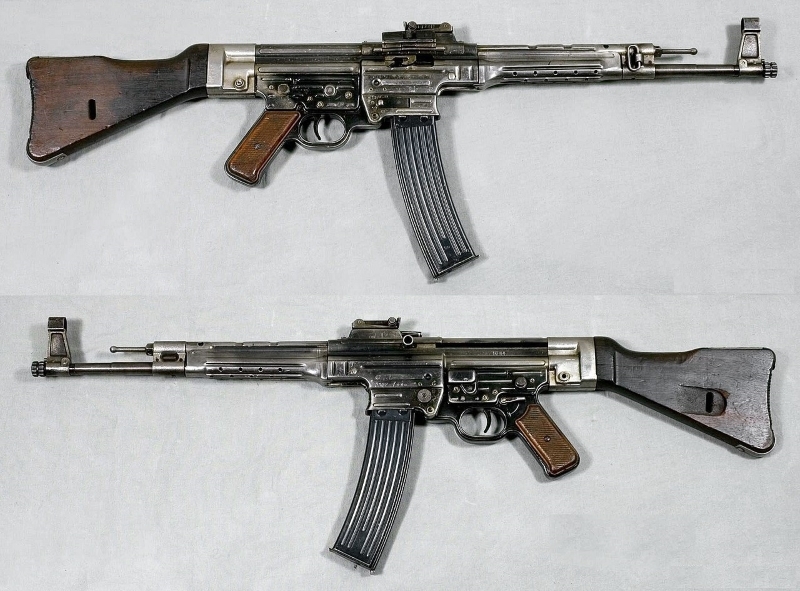It’s the Avtomat Kalashnikova. The Kalashnikov. Or just “The AK.” Have you wondered how the AK-47 platform has changed over the decades? There have been improvements over the years. Let’s take a look and see how it has evolved over the decades.
StG-44 Assault Rifle — Predecessor to the AK-47
Back in WWII, Germany developed the Sturm Gewehr (StG-44), the first Assault Rifle. They recognized the benefit of a short, maneuverable rifle that fired an intermediate cartridge (7.92x33mm). Most infantry engagements were taking place under 300 yards, so Germany geared this new weapon for those ranges. It was capable of semi or fully automatic fire and had less recoil than their bolt action K98 infantry rifles.

In doing so, Germany’s StG-44 could fill the role of the submachine gun and the rifle. Simple to manufacture, it was made largely of stampings. The StG-44 was also very easy to field strip and maintain in the field, and the troops loved it. The rate of fire was around 600 rounds per minute.
Moving Forward — The AK-47
Other countries took notice of Germany’s weapons from WWII, especially the StG-44, as it embodied many qualities that they desired. The concept itself was even revolutionary!
Enter the Soviets. At the end of WWII, they moved forward with developments of their version of the Assault Rifle. It needed to be cheap to produce, supremely reliable, easily operated by conscripts, and controllable in full automatic fire. It had to hit a target a couple hundred meters away.
The Soviets developed the 7.62x39mm intermediate cartridge, which was capable of meeting the requirements, and they settled on a 30-round magazine as the standard.
In 1949, the AK-47, developed by Mikhail Kalashnikov, was adopted by the Soviet military.

Russia supplied the Viet Cong and NVA with the AK and US forces first faced in the Vietnam War.


US Special Forces from various branches also used it in Viet Nam. They enjoyed its reliability and it sounded like the enemy’s weapons when they were operating deep in hostile territory.

Over its tenure, the rifle’s reliability has taken on legendary status. One might even say it’s mythical. All with a minimum of maintenance. There are reports of them being lubed with motor oil in the Middle East and they still keep functioning.
The 7.62x39mm Cartridge
The 7.62x39mm cartridge has a weight that is usually around 123 grains, give or take a grain or two. The Russian military version is FMJ, with velocities from the AK usually being around 2,350 feet per second. Accuracy is listed as 300 meters, but I personally think that’s a bit optimistic; the AK series is not the most accurate. I think 100-200 meters is more realistic.

The AKM
In the 1950s, the Soviets decided to simplify the process of manufacturing the AK-47 by moving from milling to stampings. The newer AKM made use of more stampings and was cheaper to produce. An added bonus is that that it is lighter than the original, milled AK-47. Basically, the AKM is the updated version of the original AK-47.

The Warsaw Pact countries adopted the AK series, including Hungary, Poland, Romania, East Germany, and others.
Provisions for night vision sight and a grenade launcher were made for the AKM.
RPK-47
Developed in the mid-1960s, the RPK filled the role of a Squad Automatic Weapon. It weighs 10.6 pounds and is 40.9 inches long. The barrel is 23.2 inches long. The rate of fire is 600 Rounds Per Minute.

The chrome-lined barrel is longer and heavier than the standard AK, allowing more sustained fire and combating heat buildup. The RPK-47 has no provision for a quick-change barrel, however. There is a bipod fitted to the end of the barrel.
Interestingly, the RPK’s receiver is about 20mm longer than that of the standard AK receiver.
Feeding can be from a standard 30-round AK magazine, but the RPK was issued with special 40-round magazines. It could also fire from a 75-round drum.
The AK-74
In the early 1960s, the Viet Nam War was ramping up. The US had adopted the M-16 with its lighter 5.56×45 round which had a much higher muzzle velocity and allowed soldiers to carry more bullets into battle. All this, with lighter recoil.
The Soviets were already exploring lighter bullets. They were 55-grain rounds fired from necked-down 7.62x39mm cases, achieving speeds in excess of 3,000 FPS.
The AK-74 was born, using a new caliber, the 5.45x39mm with bullet weights usually between 53 or 57 grains, FMJ. From the 16-inch barrel, velocities are close to 3,000 FPS.
The AK-74 was officially adopted in 1974.

The new caliber exceeded the performance of the original 7.62x39mm in many ways. Most notably in accuracy; the 5.45mm could reach out farther than the 7.62x39mm.
The smaller round produced less recoil, and the Russians also added a muzzle break, which further reduced muzzle rise and recoil. These factors make it more accurate when firing full auto.
The AK-74’s stock, pistol grip, handguards, and magazines made use of new Polymer materials. These materials made the rifle and magazines appreciably lighter, which made it possible for soldiers to carry more magazines and ammunition. All furniture is made of laminated wood, much the same as the standard AK series.
Initially, special units such as the Russian Spetznaz were issued the AK-74, with the issue to general units coming at a later time.
RPK-74
Adopted in 1974 along with the AK-74, this is the 5.45x39mm Squad Automatic Weapon. The barrel is longer and heavier than the AK-74 to help with sustained firing. Feeding is from standard 30-round AK-74 magazines (polymer or steel), but special 45-round magazines are issued with the RPK-74.

Not long after its introduction, a lighter, “modernized” version was introduced with a polymer stock, pistol grip, and handguards. A side rail mount for optics was also included.

Despite the advances of the AK-74, not every country ran out and adopted the platform. Most countries that are using the AK-47 are heavily invested in the system, with many not having, or not willing to spend, the funds to transition over. Simply put, probably half the world is using the AK-47. It’s cheap, effective, and popular.
As a result, we still see the AK-47 being used in staggering numbers around the world today. It can also be fed from a 97-round drum.

AK-12
In January 2018, the AK-12 was adopted by the Russian military. The AK-12 is the updated version of the AK-74, both being chambered for the 5.45x39mm cartridge.
One of the updates was a new stock that can be adjusted (it telescopes), to match the needs of most people. It looks suspiciously similar to some of the stock designs that we see on AR-15s/M-4s.
Other updates include Picatinny rails added all around so that optics, lights, lasers, etc. can be added. The handguard is free-floated and a suppressor can be quickly attached or detached.

The sights have also been improved; ghost ring sights are the order of the day here, and the sight radius is longer. That will add to the accuracy. The new muzzle break also functions as an efficient flash suppressor.
By all reports, the AK-12 is very soft-shooting, with very little muzzle rise. Those who fire it are amazed at how easy it is to keep on target.
RPK-16
Introduced in 2016, the RPK-16 is a Squad Automatic Weapon chambered in 5.45x39mm. It uses magazines from the AK-74 and RPK-74. Standard feed for the RPK-16 is a 95-round drum.

This SAW features a Picatinny rail for mounting optics. A heavy barrel and bipod are also available for it. Barrel lengths are 16.3 inches or 22.8 inches. Weight is 9.92 pounds. The rate of fire is approximately 700 RPM.

Conclusion
The odyssey of the AK has had some twists and turns, to be sure. At the heart, it’s not much different than when it started out. It now wears some new hardware, which improves its performance. It can still be found on battlefields, and likely will for as far forward as any of us can imagine. It’s a timeless weapon, if not a nefarious one that has been used by our enemies for decades.
I wonder what Mikhail Kalashnikov would think if he could see it today.


